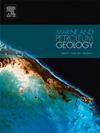Characterizing multi-scale heterogeneities in shales: An innovative workflow and application to Paleogene lacustrine shales in the Subei Basin, eastern China
IF 3.7
2区 地球科学
Q1 GEOSCIENCES, MULTIDISCIPLINARY
引用次数: 0
Abstract
Quantitative characterization of heterogeneous shales is crucial for identifying shale oil and gas sweet spots. However, there lacks methods that can be used to effectively characterize meso-scale (mm-dm) heterogeneities of shales including their compositions, structures and petrophysical properties which critically bridge the micro-to macro-scale heterogeneities. Here we propose a workflow to obtain two-dimensional representative elementary areas of heterogeneous shales through chemo-sedimentary facies analysis based on micro-XRF imaging at meso-scale. This workflow can guide sub-sampling for effective shale characterization at meso-scale and integrate micro-scale information from scanning electron microscopy with macro-scale wireline log data. To demonstrate the effectiveness of this workflow, we conducted a multi-scale characterization of mineral composition and pore structure heterogeneities on six representative lacustrine shales from the Subei Basin in eastern China. The mineral compositional heterogeneities of different lithofacies were found to be primarily influenced by paleo-water depth and seasonal climate changes, as determined through chemo-sedimentary facies analysis. Pore heterogeneities were further characterized using field emission scanning electron microscopy, low-temperature nitrogen adsorption, high-pressure mercury intrusion and fractal dimension analysis. Three distinct pore types (Type I, II, and III) were identified, with their complex relationships among mineral types, pore structures, and fractal dimensions elucidated. Type I pores exhibit H3-type hysteresis loops, Type II pores exhibit blended H2-type and H3-type hysteresis features, while Type III pores display a predominant H2-type hysteresis behavior. Heterogeneities of micropores, mesopores and macropores in shales are mainly determined by clay, carbonate and felsic mineral contents, respectively. The proposed workflow enables concurrent quantitative and in situ evaluation of heterogeneous attributes pertaining to lacustrine shales, providing valuable insights for the exploration of lacustrine shale oil and gas.
求助全文
约1分钟内获得全文
求助全文
来源期刊

Marine and Petroleum Geology
地学-地球科学综合
CiteScore
8.80
自引率
14.30%
发文量
475
审稿时长
63 days
期刊介绍:
Marine and Petroleum Geology is the pre-eminent international forum for the exchange of multidisciplinary concepts, interpretations and techniques for all concerned with marine and petroleum geology in industry, government and academia. Rapid bimonthly publication allows early communications of papers or short communications to the geoscience community.
Marine and Petroleum Geology is essential reading for geologists, geophysicists and explorationists in industry, government and academia working in the following areas: marine geology; basin analysis and evaluation; organic geochemistry; reserve/resource estimation; seismic stratigraphy; thermal models of basic evolution; sedimentary geology; continental margins; geophysical interpretation; structural geology/tectonics; formation evaluation techniques; well logging.
 求助内容:
求助内容: 应助结果提醒方式:
应助结果提醒方式:


